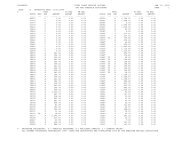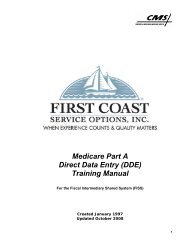Oct-Nov 00 Part A Bulletin - Medicare
Oct-Nov 00 Part A Bulletin - Medicare
Oct-Nov 00 Part A Bulletin - Medicare
Create successful ePaper yourself
Turn your PDF publications into a flip-book with our unique Google optimized e-Paper software.
LOCAL AND FOCUSED MEDICAL REVIEW POLICIES<br />
78472: Cardiac Blood Pool Imaging<br />
Policy Overview: The “Coding Guidelines” and the “ICD-9-CM Codes that Support Medical Necessity” sections of the<br />
policy has been revised to include additional guidelines affected by the implementation of the 2<strong>00</strong>1 ICD-9-CM update.<br />
Policy Number<br />
78472<br />
Contractor Name<br />
First Coast Service Options, Inc.<br />
Contractor Number<br />
090<br />
Contractor Type<br />
Intermediary<br />
LMRP Title<br />
Cardiac Blood Pool Imaging<br />
AMA CPT Copyright Statement<br />
CPT codes, descriptions, and other data only are<br />
copyright 1998 American Medical Association (or such<br />
other date of publication of CPT). All Rights Reserved.<br />
Applicable FARS/DFARS Apply.<br />
HCFA National Coverage Policy<br />
N/A<br />
Primary Geographic Jurisdiction<br />
Florida<br />
Secondary Geographic Jurisdiction<br />
N/A<br />
HCFA Region<br />
Region IV<br />
HCFA Consortium<br />
Southern<br />
Policy Effective Date<br />
03/15/2<strong>00</strong>0<br />
Revision Effective Date<br />
10/01/2<strong>00</strong>0<br />
Revision Ending Effective Date<br />
09/30/2<strong>00</strong>0<br />
Policy Ending Date<br />
N/A<br />
LMRP Description<br />
Radionuclide ventriculography is one of the most<br />
widely used techniques for evaluating ventricular function.<br />
This essentially noninvasive method of assessing ventricular<br />
function can be easily performed and provides a<br />
reproducible, accurate evaluation of both right ventricular<br />
and left ventricular function. Currently, there are two<br />
techniques for assessment of ventricular performance using<br />
radionuclides: the first-pass technique and gated blood pool<br />
imaging. Information that can be derived from these studies<br />
include assessment of left and/or right ventricular ejection<br />
fraction, regional wall motion, left ventricular volumes, and<br />
diastolic function.<br />
Gated blood pool imaging (multigated acquisition, or<br />
MUGA), also known as equilibrium radionuclide<br />
angiocardiography, is the most widely used technique to<br />
assess ventricular function. In this technique, the patient’s<br />
erythrocytes are labeled with technetium-99m and the<br />
imaging is performed by synchronizing acquisition to the R<br />
wave of the electrocardiogram (ECG). Sampling is<br />
performed repetitively over several hundred heartbeats with<br />
physiological segregation of nuclear data according to<br />
occurrence within the cardiac cycle.<br />
First-pass radionuclide angiocardiography utilizes a<br />
high-count-rate gamma camera and involves sampling for<br />
only seconds during the initial transient of the technetium-<br />
99m bolus through the central circulation. The highfrequency<br />
components of this radioactive passage are<br />
recorded and analyzed quantitatively. After data acquisition,<br />
right and left ventriculograms are constructed from which<br />
ejection fractions and ventricular volumes can be calculated.<br />
Indications and Limitations of Coverage<br />
and/or Medical Necessity<br />
Florida <strong>Medicare</strong> will consider cardiac blood pool<br />
imaging studies medically reasonable and necessary for the<br />
following indications:<br />
• Evaluation of a patient with suspected or known<br />
Coronary Artery Disease (CAD). A radionuclide<br />
ventriculogram assists in stratifying patients into low<br />
and high risk, thereby providing prognostic value.<br />
However, perfusion imaging is superior to exercise<br />
radionuclide ventriculograms. Therefore, current<br />
practice is to perform stress myocardial perfusion<br />
imaging in patients with suspected CAD.<br />
• Evaluation of a patient after a Myocardial Infarction<br />
(MI). Assessment of the impact of the MI on<br />
ventricular function, identification of the physiologic<br />
importance of coronary stenosis outside the infarct<br />
distribution (i.e., extent in which viable myocardium is<br />
jeopardized), and risk stratification for future cardiac<br />
events is determined. Normally, a resting study is<br />
recommended.<br />
• Assessment of right ventricular function, especially in<br />
patients with cor pulmonale or an acute inferior MI<br />
caused by right ventricular infarction.<br />
• Evaluation and monitoring of a patient with dilated or<br />
hypertrophic cardiomyopathy. Restrictive<br />
cardiomyopathy is normally diagnosed with other<br />
noninvasive methods, therefore, radionuclide studies do<br />
not have a role in the diagnosis of restrictive<br />
cardiomyopathy.<br />
• Evaluation of a patient with suspected or known<br />
valvular heart disease to determine ventricular function<br />
and estimate the degree of valvular regurgitation. Serial<br />
evaluations may be necessary in patients with<br />
asymptomatic aortic regurgitation to determine surgical<br />
timing. In addition to obtaining a resting left ventricular<br />
ejection fraction (usually by the gated blood pool<br />
technique) in the timing of surgery, exercise duration is<br />
also a key indicator.<br />
• Evaluation and management of a patient with congestive<br />
heart failure. The most important imaging procedure is<br />
two-dimensional echocardiography, which can evaluate<br />
ventricular chamber size, regional and global wall<br />
motion, left ventricular wall thickness, and valvular<br />
22 The Florida <strong>Medicare</strong> A <strong>Bulletin</strong><br />
<strong>Oct</strong>ober/<strong>Nov</strong>ember 2<strong>00</strong>0





